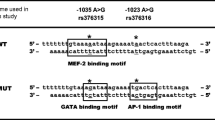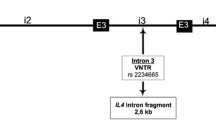Abstract.
Genotypic variation in the human interleukin-10 (IL-10) promoter may account for marked inter-individual variation in IL-10 production and may influence susceptibility to autoimmune diseases. The G/A polymorphism at position -1082 has been linked to high/low IL-10 producer status. We directly tested the functional significance of this polymorphism using DNA-binding assays and reporter gene assays, examined allele frequencies in two geographically distinct populations and assessed intra- and inter-individual variation in IL-10 production in vitro according to genotype. Functional analyses showed that the -1082 region contains a putative ETS-like transcription factor-binding site, and nuclear factors from a monocyte cell line bind to this region. Transient transfection studies in an Epstein-Barr virus-transformed B cell line indicated that the -1082 A allele confers a two fold increase in transcriptional activity of the IL-10 promoter compared to the G allele. There was marked inter-individual variation in IL-10 production by peripheral blood mononuclear cells in vitro, with no consistent effect of genotype.
Similar content being viewed by others
Author information
Authors and Affiliations
Additional information
Received 26 October 2001; received after revision 21 December 2001; accepted 18 January 2002
Rights and permissions
About this article
Cite this article
Rees, L., Wood, N., Gillespie, K. et al. The interleukin-10 - 1082 G/A polymorphism: allele frequency in different populations and functional significance. CMLS, Cell. Mol. Life Sci. 59, 560–569 (2002). https://doi.org/10.1007/s00018-002-8448-0
Issue Date:
DOI: https://doi.org/10.1007/s00018-002-8448-0




